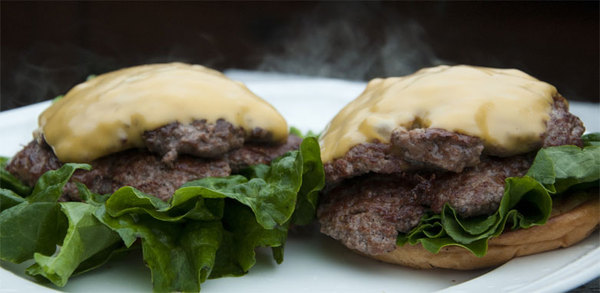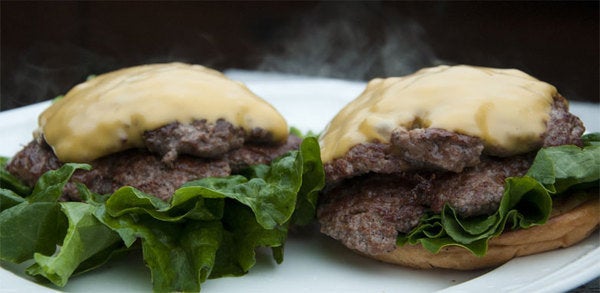
"Give a man a burger and he will gladly pay you Tuesday. Teach a man to make a burger and he will feed his family as if every day is Sunday." Meathead
Close your eyes and think of the best hamburger you've ever had. In a restaurant, right? Let's fix this. Let's all go from Grasshopper to Burger Zen Master.
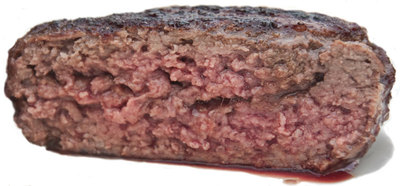 Let me guess what is in your memory: You needed two hands and two napkins. The toasty charry beefy scent wafted to your nose as it was escorted to your table. The perfume told your mouth to start the lube moving the moment the plate became visible. It almost smelled burnt, but it was not. As you lifted the top of the bun to add ketchup, you saw that the patty had a mahogany skin and the bun was wet with dark juices that looked like Suwannee River. It was crunchy when your teeth pierced it. The warm, salty juices flowed over your tongue followed closely by an assertively deep prime steak flavor, like a steakhouse steak framed by the irresistible bracing flavor of roasted beef fat. The bun was warm, buttery and crispy on the inside, and condiments amped up the experience, but you really can't remember them. It was the succulent brawny beef that sticks in your mind. The experience ended, reluctantly, with licking the juice off your elbows.
Let me guess what is in your memory: You needed two hands and two napkins. The toasty charry beefy scent wafted to your nose as it was escorted to your table. The perfume told your mouth to start the lube moving the moment the plate became visible. It almost smelled burnt, but it was not. As you lifted the top of the bun to add ketchup, you saw that the patty had a mahogany skin and the bun was wet with dark juices that looked like Suwannee River. It was crunchy when your teeth pierced it. The warm, salty juices flowed over your tongue followed closely by an assertively deep prime steak flavor, like a steakhouse steak framed by the irresistible bracing flavor of roasted beef fat. The bun was warm, buttery and crispy on the inside, and condiments amped up the experience, but you really can't remember them. It was the succulent brawny beef that sticks in your mind. The experience ended, reluctantly, with licking the juice off your elbows.
So what are the secrets of a Zen Master's Burger? Finding out has taken me a whole year, a longer odyssey than any other cooking technique I've tried to conquer on your behalf. Whooda thunk the humble burger was such a pain?
Don't expect perfection the first time you try my methods, but do expect improvement. You'll get closer each time you do it. By the third attempt you should have everyone's attention.
Remember, in any form of experiment, you must set up a repeatable system in which you can change only one variable at a time. If you make your first batch on a charcoal grill, don't switch to a cast iron griddle and change the meat blend at the same time. One variable at a time.
Soon you'll know what the restaurants and I know: You'll know the gestalt of the Zen Master's Burger and be well on your way to making your home a hamburger heaven.
Begin by throwing out all your preconceived notions about cooking burgers.
Never buy "hamburger" or "ground beef" for burgers
Never ever ever nohow noway buy something labeled "hamburger" or "ground beef" for burgers. Nobody knows what's in it! Technically the difference is that, if the meat is packed at a USDA inspected plant, "hamburger" can have fat scraps added and "ground beef" cannot. But the USDA inspects only meat that crosses state lines, so if it is ground by your grocer, practically any muscle can be in there. Butchers toss trimmings from any old cut in there, and much of the stuff in preformed patties comes from old bulls and no longer productive dairy cows, not known for the tastiest meat.
A maximum of 30% fat by weight is allowed in either hamburger or ground beef and both may have seasonings, but no water, phosphates, extenders or binders added.
Much hamburger and ground beef comes from processing plants many miles away and if it is not frozen, it can be several days old when you buy it.
Here's the kicker: Much of this dreck has been treated with ammonia to kill microbes, and the result is called pink slime. Yet the ammonia does not have to be listed as an ingredient.
Keep in mind that your grocer and butcher may grind and package their own meat at a central warehouse or in the store, and their facilities are not USDA inspected unless they ship across state lines. The fat content laws, however, apply to all grinders.
Buying beef pre-ground at the grocery
Hamburger or Ground Beef can legally come from practically any muscle on the animal. You know the old joke about "lips and sphincters?" You got it. They usually contain up to 30% fat, may include seasonings and flavor additives, may be treated with ammonia (yes, ammonia), may be frozen and then defrosted. Don't buy it.
Ground Chuck comes from the shoulder and usually ranges from 15 to 20% fat. It has good flavor and texture, especially if freshly ground.
Ground Round comes from the rump and usually runs 10 to 15% fat. It can be dry and tough, but has a nice beefy flavor.
Ground Sirloin comes from the area just in front of the hip, and is usually about 5 to 10% fat. Tends to be dry because it is so low in fat. Can be pricey.
Remember, you can always ask your butcher to custom grind steaks for you and you can even ask for some ground fat on the side to blend in. If you ask for the butcher to grind in extra fat, you will pay the same price as the meat. My butcher gives me ground fat on the side for free, and I mix it myself.
Buy meat and have your butcher grind it for you
Whenever possible you should ask your butcher to grind your meat while you wait. You pick the steak, and she grinds it.
Pre-ground meat, even some of the better cuts of pre-ground meat, such as ground chuck, may have been ground miles away and days ago. Once meat is ground, it begins to oxidize, and the longer it sits, the larger the microbial colony becomes. Ground meat labeled "hamburger" is higher risk because it is made from trimmings and scrap.
If you want to buy ground meat, try to buy it at a store with a butcher in the back room who can grind for you. In grocery stores, butchers usually come in early in the morning, and leave before 5 p.m. They are probably not on duty on Sunday. Find out when your butchers are in, and get to know them by name. Ask them to grind meat for you.
You want at least 20% fat, not 15% as called for in many cookbooks and online recipes. Many top chefs now recommend 20 to 30% fat, especially if you cook the meat to USDA recommended safe temps of 160°F. That's right, you do not want a lean burger because fat brings a lot of flavor, moisture, and crispness to the party, and it helps hold the patty together. Face it, burgers are not diet food so we can't eat them every day. But when we do crave one we want a good one, and that means at least 20 to 30% fat.
The easiest thing to do is pick a nice looking "choice" grade chuck, with plenty of fat, and if necessary, ask the butcher to add some fresh white fat trimmings to get the blend up to 20 to 30%. Go ahead. Get it 30%. Especially if you plan to cook it til it is safe. Just don't tell your cardiologist.
Ask for a coarse grind, using the 1/4" holes, only once through the grinder, and ask for it to be packaged loosely. Many butchers grind beef fine or grind it twice. Not for you. It should come out looking like thick wavy spaghetti. Coarser grinds and looser pack make for an uneven surface plus air pockets inside, and that's good.
If you can't get your meat ground to order, buy pre-ground chuck which is usually about 15 to 20% fat. Ground round is usually about 10 to 15% fat. If you buy ground sirloin, you are getting only about 5 to 10% fat. Alas, these are not precise standards. The fat content can vary from one store to another, from one steer to another.
While you're at it, ask for some suet (beef fat) to freeze and mix in the next time your meat is too lean. I have never been charged for it. Your butcher may even grind it for you. If not, you can grind it easily in a food processor. Don't get just any fat. You want fresh white fat, not yellow fat. I've been known to freeze fat trimmed from my briskets and add it to my burger grind. Wrap it tightly in plastic first, and don't keep it for more than 60 days or it can start to taste funky. You can also use suet to coat your griddle or pan if you are making Diner Burgers.
Better still, grind your own
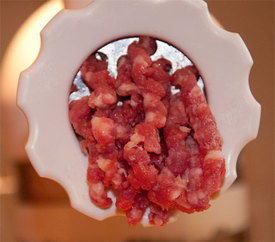 The best way to control quality is to grind your own hamburgers. That way you can select the exact cut from the counter, control the fat to lean ratio, get the freshest meat, reduce oxidation and even reduce risk. Click here for my article on grinding your own hamburger meat. It's easier than you think.
The best way to control quality is to grind your own hamburgers. That way you can select the exact cut from the counter, control the fat to lean ratio, get the freshest meat, reduce oxidation and even reduce risk. Click here for my article on grinding your own hamburger meat. It's easier than you think.
While you're at it, if you have lean steaks, add finely chopped raw bacon into the blend. Select the fattiest strips. This is an amazingly effective trick, and bacon brings flavor and salt. That's why we love bacon on top of our burgers.
The best cuts and grades for grinding
Don't waste money on the tenderest steak cuts from along the back of the steer: Ribeye, filet, or strip. The grinding process will make tough cuts tender. The Hamburger Zen Master wants inexpensive meat that has great beefy flavor like short ribs (side), chuck (shoulder), flank steak (belly), skirt steak (mid-chest), sirloin (hip), hanger steak (diaphragm), or brisket (front-chest).
Vogue Magazine's esteemed food writer Jeffrey Steingarten reports that most of New York City's best burgers are a blend of chuck and brisket, with some chefs adding hanger steak or short rib meat. His personal house blend is two parts chuck, two parts short rib, and one part brisket. That seems like a lot of trouble to me.
 Short ribs. This is my favorite cut of meat for hamburger, tastewise. It packs good steak flavor, and, even though it is a tough cut of meat, if ground and cooked properly, it can produce excellent burgers. My favorite burgers are 100% shorties. But this is a more expensive cut than chuck (below) unless you can catch it on sale.
Short ribs. This is my favorite cut of meat for hamburger, tastewise. It packs good steak flavor, and, even though it is a tough cut of meat, if ground and cooked properly, it can produce excellent burgers. My favorite burgers are 100% shorties. But this is a more expensive cut than chuck (below) unless you can catch it on sale.
Short ribs come from the short plate, from the side of the steer, and are usually heavily marbled with 20 to 30% fat. Read my article on The Zen of Beef Ribs. Most of the time they come with a bone attached, so you'll have to cut it off and save the bones for soup or stock. Sometimes you can get them boneless. First you have to cut the top layer of fat off because there's a tough "silverskin" below it most of the time. You want to see meat on the top. Then you cut it off the bone. There's a leathery cartilage between the meat and bone, so leave it behind. Bone in, there's about 50% waste after you cut the meat off the bones and discard the silverskin. But you can simmer the bones with carrots, celery, and onion to make a nice beef stock. I have had problems grinding short ribs in my Kitchen Aid because there is some gristle that clogs the plate, so I often ask my butcher to grind it with her heavy duty grinder.
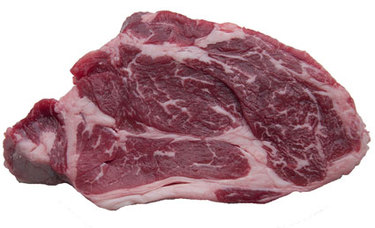 Chuck. This is the cut most of the top burger joints use. Chuck steaks come from the shoulder. You can get either boneless or bone in, it doesn't matter. But get chuck steaks not chuck roast. Chuck roast has too much sinew, and if you try to grind it yourself the leathery sinew will just clog the grinder. Look for steaks that have, to your eyeball, 20 to 30% fat. That's an 8 ounce chuck eye steak below at $3.99 a pound. Chuckeye is cut from the part of the shoulder just in front of the ribeye (they are pretty tasty grilled at a much lower price than ribeye, but that's another article).
Chuck. This is the cut most of the top burger joints use. Chuck steaks come from the shoulder. You can get either boneless or bone in, it doesn't matter. But get chuck steaks not chuck roast. Chuck roast has too much sinew, and if you try to grind it yourself the leathery sinew will just clog the grinder. Look for steaks that have, to your eyeball, 20 to 30% fat. That's an 8 ounce chuck eye steak below at $3.99 a pound. Chuckeye is cut from the part of the shoulder just in front of the ribeye (they are pretty tasty grilled at a much lower price than ribeye, but that's another article).
Flank, skirt, hanger and sirloin. These are really beefy tasting cuts, but they are lean. So I often ask for extra white fat from the butcher or blend bacon fat into the patties.
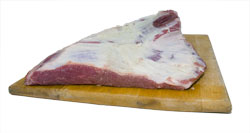 Brisket. Brisket has a big hearty flavor. There are two parts of the brisket (described in detail in my article on Texas Brisket). The "point" cut of brisket has about the right fat to lean ratio for burgers, and a lot more fat on top of it. You'll need to trim the fat cap off to get to the right ratio. The "flat" cut of brisket is a slab of lean meat with a 1/4" or so thick fat cap on top. Because the fat and lean are easy to separate, you can measure and blend the ratio you want fairly accurately.
Brisket. Brisket has a big hearty flavor. There are two parts of the brisket (described in detail in my article on Texas Brisket). The "point" cut of brisket has about the right fat to lean ratio for burgers, and a lot more fat on top of it. You'll need to trim the fat cap off to get to the right ratio. The "flat" cut of brisket is a slab of lean meat with a 1/4" or so thick fat cap on top. Because the fat and lean are easy to separate, you can measure and blend the ratio you want fairly accurately.
The bottom line. The esteemed cookbook author Michael Ruhlman says the cut is not as critical as the ratio of beef to fat. "Beef is beef and, unlike pork, beef tastes like beef no matter where it comes from on the animal. I know people will disagree. I believe the only critical ratio is the meat to fat, so I buy a nice fatty relatively inexpensive chuck steak, and that gives me a great burger every time. Short ribs will give you a great burger as well. So will sirloin and brisket if you've got the right amount of fat."
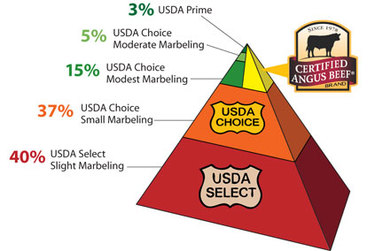 Go for USDA Choice grade beef, not the more expensive prime grade, the fabulously expensive kobe or wagyu. Expensive cuts are so dear because they have more fat between the muscles than choice beef. But you can add fat to ground meat, so why spend much much more on prime, kobe or wagyu? Certified Angus is at least choice in grade, so even though it is slightly more, it is a good choice.
Go for USDA Choice grade beef, not the more expensive prime grade, the fabulously expensive kobe or wagyu. Expensive cuts are so dear because they have more fat between the muscles than choice beef. But you can add fat to ground meat, so why spend much much more on prime, kobe or wagyu? Certified Angus is at least choice in grade, so even though it is slightly more, it is a good choice.
Mix-ins
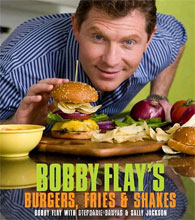 There is a raging controversy over the wisdom of mixing ingredients into the patty. On one side, there's FoodNetwork's Bobby Flay, author of the cookbook Bobby Flay's Burgers, Fries & Shakes, and owner of nine restaurants, among them three locations of Bobby's Burger Palace. He's a minimalist. His patties are nothing but chuck, and he sprinkles salt and pepper on the exterior just before cooking. He once told me "I don't put anything in my burgers like onion, eggs, breadcrumbs, anything. That's meatloaf." And that's harsh!
There is a raging controversy over the wisdom of mixing ingredients into the patty. On one side, there's FoodNetwork's Bobby Flay, author of the cookbook Bobby Flay's Burgers, Fries & Shakes, and owner of nine restaurants, among them three locations of Bobby's Burger Palace. He's a minimalist. His patties are nothing but chuck, and he sprinkles salt and pepper on the exterior just before cooking. He once told me "I don't put anything in my burgers like onion, eggs, breadcrumbs, anything. That's meatloaf." And that's harsh!
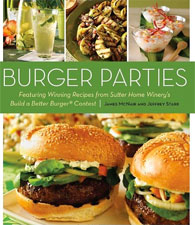 On the other side is James McNair. Nobody has tasted more burgers than McNair, Honorary Chairman and Head Judge of Sutter Home Winery's Build a Better Burger Contest, founded in 1990, and by far the biggest and most important burger competition in the world, with $50,000 prize going to the best beef burger, and $10,000 to the best "alternative" burger (pork, salmon, turkey, etc.). McNair is also the author of two books on burgers that are still available, Build A Better Burger: Celebrating Sutter Home's Annual Search for America's Best Burgers, and his most recent, co-authored by Jeffrey Starr, Burger Parties: Recipes from Sutter Home Winery's Build a Better Burger Contest. He told me "To incorporate flavor into every bite, thoroughly mix seasonings into the ground ingredients. Contrary to popular culinary myth, salting ground meat a few minutes before cooking will not draw out the moisture and create a dry burger. For our tastes, one teaspoon of kosher or coarse sea salt to every pound of meat is a perfect ratio, but if you're adding other salty components, reduce the amount of salt you use."
On the other side is James McNair. Nobody has tasted more burgers than McNair, Honorary Chairman and Head Judge of Sutter Home Winery's Build a Better Burger Contest, founded in 1990, and by far the biggest and most important burger competition in the world, with $50,000 prize going to the best beef burger, and $10,000 to the best "alternative" burger (pork, salmon, turkey, etc.). McNair is also the author of two books on burgers that are still available, Build A Better Burger: Celebrating Sutter Home's Annual Search for America's Best Burgers, and his most recent, co-authored by Jeffrey Starr, Burger Parties: Recipes from Sutter Home Winery's Build a Better Burger Contest. He told me "To incorporate flavor into every bite, thoroughly mix seasonings into the ground ingredients. Contrary to popular culinary myth, salting ground meat a few minutes before cooking will not draw out the moisture and create a dry burger. For our tastes, one teaspoon of kosher or coarse sea salt to every pound of meat is a perfect ratio, but if you're adding other salty components, reduce the amount of salt you use."
McNair's assertion is contested by J. Kenji Lopez-Alt, a former chef and Associate Editor at Cooks Illustrated and now an editor at SeriousEats.com. In a noteworthy experiment, well-designed and documented in the MIT grad's "Burger Lab", he tested salting patties internally and externally and came to the conclusion that external is better. He demonstrates that salt makes the meat mushy. Now he just sprinkles salt liberally on the surface just before cooking. Me too. I believe in Kenji.
But there should be no rules in the dining room or the kitchen, so I say there's room in the firmament for what I call the Homestyle Burger. It's the burger Granny made, with chopped onions, peppers, and more. Watch for my recipe.
Meathead's Mix-ins
I'm partial to one of two styles, the Steakhouse Steakburger or the Diner Burger, so I usually mix freshly ground black pepper, onion powder, and garlic powder together, and sprinkle it evenly on the ground meat before forming the patties. I mix in the seasonings because they just burn and get bitter when sprinkled on the surface. But I do salt the surface liberally just before cooking or while on the grill. Occasionally, if I want to do something wild and crazy, I sprinkle some of my Cow Crust spice blend in the mix (click the link for the recipe). But I never add salt.
If the meat is a bit too lean, mix in some finely chopped, uncooked fatty bacon. Avoid adding wet ingredients like wine, Worcestershire sauce, etc. They require you to work the meat hard to mix them in, and they can retard browning of the surface.
Ingredients
1 pound ground steak, 20 to 30% fat
1/4 teaspoon freshly ground black pepper
1/4 teaspoon onion powder
1/4 teaspoon garlic powder (not garlic salt)
Do this
For Steakhouse Steakburgers, put the meat in a bowl, sprinkle in some of the spice mix and stir it with a fork to keep it fluffy. For Diner Burgers, you can mix them by hand and pack them tight.
Forming the patties
Learn to make uniform sized burgers every time so you can get a sense for how long it takes to cook them properly. Do not use cold water on your hands as is popularly advised. We don't want wet meat which can also retard crisping.
Steakhouse Steakburgers go 6 to 8 ounces each and pack them loosely with your hands so there are pockets to hold the juices. Make them 1/2 to 3/4" thick. It has become fashionable to make indentations in burgers on the theory that they will puff out. I don't bother. There's no harm in a little bulge. Click this link for specifics about Steakhouse Steakburgers.
Diner Burgers, which are cooked on a griddle or in a pan for maximum surface browning, you need thinner burgers, and to keep them from falling apart, you need to pack them a bit tighter. Make 4 ounce balls and chill them in the fridge for 20 minutes or more. The cold center will help keep them from overcooking. Click this link for specifics about Diner Burgers.
If you wish, you can use an ice cream scoop. They have numbers on them. A #8 holds 4 ounces (a quarter pounder, just right for a Diner Burger). Two scoops and you've got a Steakhouse Steakburger.
Key concepts of cooking hamburgers
The way to get your burgers done properly is the same way you get to Carnegie Hall: Practice. Practice. Practice. You may have to experiment three or four times to perfect your technique. But you'll get it, and then all who know you will prostrate themselves in your path.
The secret to any experiment is to change only one variable at a time and take notes or keep a cooking log. For example, if you are cooking with charcoal, count the briquets so you can use the same amount every time. If you are using gas, use the same settings every time. But remember, wind and air temp will influence the cooking. If you cook in a frying pan, use the same pan every time. A black cast iron pan will produce different results than a shiny stainless steel pan. If you oil the pan with beef fat, do the same thing every time. Butter and cooking oil have different heating and flavor characteristics.
Most importantly, at the experimental stage, never vary the thickness of your burger or the temp at which you cook it. Then you will get a sense for how long it takes to get it done properly, and you can learn the color of the outside and the feel of the meat that tells you when the inside is ready. As you approach perfection, you can fine tune cooking temp and thickness.
To achieve Burger Zen Master status, you must understand the concepts covered in my articles on meat science and thermodynamics of cooking. A short recap of germane points:
The perfect burger has two parts, the exterior and the interior. You want the exterior as dark as possible, but not black, and you want the interior juicy and safe. You want beefy flavor unmasked by condiments and mix-ins.
The exterior. The surface is significantly impacted by the cooking method. If the meat is cooked on a hot griddle, as it is in most diners, the surface is in direct contact with the heat and it cooks by conduction, browning evenly across the surface. If it is cooked on a grill, most of the meat cooks by radiant heat. The small amount of surface where the meat is in contact with the grates cooks by conduction.
First, generously season the exterior with salt just before cooking. Then spread a thin layer of oil on the exterior. If you oil the patty you make it harder for moisture to escape, plus the oil transmits heat faster to the meat, so you don't need to oil the griddle, pan, or grates. Fat helps the Maillard reaction and caramelization, two chemical changes that create dark brown color, crunchy texture and a deeper, richer, sweeter flavor.
The interior. The center of the burger doesn't care much about which method of cooking you use because it cooks by heat conducted from the exterior. As the surface gets hot, moisture and fats transfer the heat like a bucket brigade from the outside in. You cannot tell by the color of ground meat if it is cooked safely. Some burger interiors turn brown as low as 130°F, so a brown burger can still be rare.
Size matters
There are two very different cooking methods depending on whether you are doing thick Steakhouse Steakburgers or thin Diner Burgers. For details, read my articles on Steakhouse Steakburgers and Diner Burgers.
What are your burger secrets?
All text and some photos are Copyright (c) 2012 By Meathead, and all rights are reserved. For more of Meathead's writing, photos, recipes and barbecue info please visit his website AmazingRibs.com and subscribe to his email newsletter, Smoke Signals.
Friend Meathead on Facebook: http://www.facebook.com/AmazingRibs
